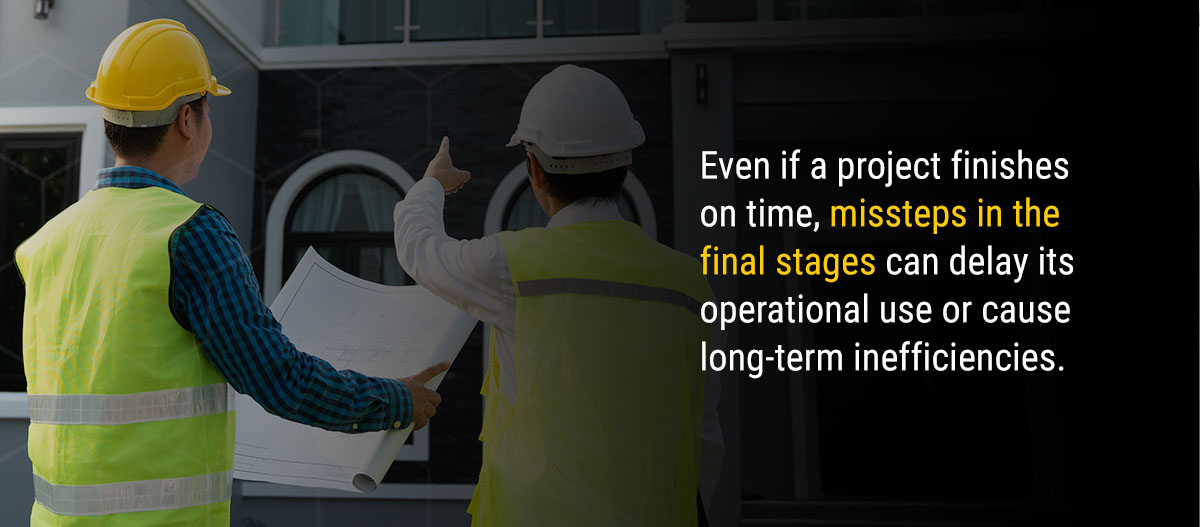
Delays in construction projects can disrupt schedules, increase costs, and strain relationships among stakeholders. For contractors, subcontractors, and project managers, downtime can impact profitability, trust, and project success. Setbacks can stem from issues like equipment failure, unpredictable weather conditions, and economic changes. Addressing these concerns can save time and money.
Reducing downtimes helps projects run smoothly, keeps budgets on track, and increases team efficiency. Learn more about the impact of construction delays and ways to mitigate setbacks.
Causes of Construction Project Delay
Here are the common causes of construction project delays:
1. Equipment Breakdown
One of the most common construction delays happens because of equipment failure. The reasons behind equipment failure often stem from:
- Lack of preventive maintenance: Neglecting routine checks and tune-ups can lead to wear and tear that goes unnoticed until it causes a breakdown.
- Operator error: Inadequate training or improper use of machinery can cause strain on equipment.
- Harsh operating conditions: Prolonged use in extreme weather, uneven terrain, or exposure to dust and debris can accelerate damage to machinery.
- Age and usage: Older equipment with extensive use is prone to malfunction. Overloading machines or using them beyond their capacity can also hasten breakdowns.
2. Budget Constraints
Budgets cover labor, materials, permits, equipment, and contingency plans. Project managers, contractors, and clients must carefully balance these elements for the project to stay financially viable. However, unforeseen expenses happen. Maybe material costs spike because of market fluctuations or unexpected site conditions require additional resources. When this happens, teams may face financial shortfalls that halt progress.
Another common issue is delayed funding. For example, if a government project relies on approval for additional budget allocation or a private project hinges on a client securing a loan, work may be paused until the financial situation is resolved.
3. Weather Conditions
Even with advanced planning, sudden shifts in weather patterns can catch teams off guard. Weather constraints can cause:
- Workforce safety hazards: Icy surfaces, lighting storms, or excessive heat can create safety hazards, forcing crews to stop work to avoid accidents.
- Material damage: Rain or snow can damage exposed materials, requiring replacement or repairs.
- Equipment malfunction: Heavy rainfall or freezing temperatures can make equipment unsafe or inoperable until conditions improve.
4. Communication Breakdowns and Supply Chain Disruptions
Construction sites have countless moving parts, each dependent on the other. A misunderstanding — whether it’s about project specifications, schedules, or resource allocation — can create errors. If a contractor misunderstands the timeline for when materials need to arrive, workers may be left idle, waiting for deliveries. Alternatively, a missed update about site readiness could mean subcontractors show up with no tasks to complete. Each scenario wastes time and resources while pushing deadlines further.
The construction industry typically relies on a well-oiled supply chain. From raw materials like steel and concrete to specific components like roofing shingles or heating, ventilation, and air conditioning (HVAC) systems, every element must arrive on time and in the right quantity. However, the project suffers when this chain breaks because of global shortages, shipping delays, or supplier insolvency.
5. Unforeseen Site Conditions
The foundation of any construction project begins with the land itself. Detecting any issues with the site just as you’re about to begin operations may require additional time, expertise, and resources. A few common site conditions that can halt operations include:
- Subsurface challenges: Unexpected high water tables or soil instability may require changes to foundation designs or excavation methods.
- Environmental concerns: Contaminated soil or protected wildlife habitats can trigger regulatory interventions and halt work until solutions are implemented.
- Hidden utilities: Pipes, cables, or infrastructure not identified during surveys can cause setbacks or damage if accidentally disturbed.
6. Labor Shortages and Poor Project Planning
Contractors have trouble finding skilled workers. However, this isn’t just about not having enough hands on deck. It’s about not having the right ones. Skilled labor is critical for completing specialized tasks. When these roles go unfilled, tasks pile up, and projects lag behind. A lack of experienced workers can be due to an aging workforce, with many skilled professionals retiring and fewer young workers entering the trades.
Planning errors often stem from unrealistic deadlines, inadequate risk assessment, or a failure to coordinate among teams. For example, scheduling multiple trades to work simultaneously in the same area can lead to clashes, rework, and wasted time. When planning falls short, the project team constantly needs to adjust, reassign tasks, or troubleshoot problems that should have been anticipated.
7. Economic Changes
Economic shifts influence material costs, labor availability, financing, and demand for construction services. Economic changes often present themselves in the following ways:
- Material cost inflation: Rapid inflation drives up the cost of essential construction materials. This can strain budgets and force project managers to suspend work while securing additional funding or finding alternative suppliers.
- Labor market disruptions: Economic downturns may lead to layoffs or worker shortages. Conversely, economic booms may cause labor costs to rise as demand for skilled workers increases.
- Interest rate fluctuations: Rising interest rates make financing for construction projects more expensive, slowing down new developments or forcing project reevaluations.
- Global supply chain instability: Recessions or geopolitical tensions often ripple through supply chains, causing lags in delivering critical materials or equipment.
8. Project Complexity
Complex projects often have multiple layers of planning, coordination, and execution. Complexity in construction can stem from these elements:
- Size and scope: Large projects involve numerous phases and require careful sequencing of tasks.
- Design intricacies: Unique architectural features or advanced engineering designs might require specialized skills, materials, and techniques.
- Stakeholder involvement: A project involving multiple stakeholders may introduce more opportunities for miscommunication and misaligned goals.
- Site constraints: Projects with limited space, accessibility challenges, or environmentally sensitive areas can add to the complexity.
9. Permitting and Regulatory Delays
Permits ensure safety standards, environmental protection, and compliance with local laws. However, obtaining these permits can be a time-consuming process. Delays in permitting can lead to expired material quotes and seasonal constraints that weren’t originally an issue.
Permitting and regulatory problems may stem from the following:
- Complex approval processes: Building, environmental, zoning, and utility permits may involve separate agencies, each with its own requirements. The larger and more complex the project, the longer this process may take.
- Inadequate documentation: Missing details, errors, or noncompliance with local codes can lead to rejection or repeated revisions.
- Changing regulations: A project started under one set of rules may face setbacks if new policies are introduced mid-project, requiring compliance adjustments.
- Environmental and community concerns: Construction in environmentally sensitive areas or near residential communities may require additional environmental impact assessments or public consultations.
10. Design Changes, Rework, and Project Scope Changes
Late-stage design changes are a common cause of rework, which means downtime. If an error in a blueprint is discovered halfway through construction, teams may need to demolish or rebuild sections to meet new specifications. Client requests or evolving project needs can also cause scope changes. These changes can disrupt schedule, budget, and resource allocation. For example, adding a custom feature to a building might delay material orders and labor schedules.
11. Lack of Post-Execution Phase Management
The post-execution phase involves final inspections, punch list completion, and handover to the client. Even if a project finishes on time, missteps in the final stages can delay its operational use or cause long-term inefficiencies. For example, incomplete documentation or unresolved defects can prevent timely approval from regulatory bodies or disrupt the client’s plans for occupancy or usage.
The Impact of Construction Delays
Here are the downsides of common construction delays.
Increases Project Costs
Delays almost always result in higher costs. Contractors and clients face escalating expenses as projects stretch beyond their intended timelines. Contractors may face penalties for failing to meet deadlines specified in contracts. Similarly, clients might be burdened with additional materials, labor, and extended site management costs.
Hinders Decision-Making and Disrupts Financial Stability
Since economic instability creates uncertainty, this can delay decision-making or result in the following:
- Project rescheduling: Developers may postpone or phase projects to spread out costs.
- Budget overruns: Inflation or rising interest rates can cause budgets to balloon.
- Funding withdrawals: Investors or lenders may pull back funding in response to economic uncertainty, causing indefinite project delays.
Creates a Loss of Revenue and Missed Opportunities
A delayed completion means clients cannot start generating revenue from the completed facility. For example, if the construction of a processing plant is delayed, a company cannot begin operations. Similarly, delayed infrastructure projects may leave local governments unable to provide critical services to their communities. This loss extends to missed opportunities as well. Delays can cause companies to miss favorable market conditions or fail to capitalize on seasonal demands.
Damages Reputation and Loss of Trust
Delays can tarnish a contractor’s or company’s reputation if they occur frequently or are poorly managed. Clients expect professionalism and reliability. When projects are suspended, confidence in a contractor’s ability to deliver on promises erodes. This affects future business opportunities because word of mouth and industry reputation contribute to securing contracts. From the client’s perspective, delays can strain relationships with their own stakeholders.
Reduces Worker Productivity and Morale
Workers left idle during downtime may experience a drop in productivity and morale. When equipment malfunctions halt operations, workers have little to do but wait. This waiting may breed frustration and disengagement, negatively impacting productivity when the project resumes. Subcontractors may become dissatisfied if delays disrupt their schedule for other projects because construction is a collaborative industry. Low morale among workers can lead to mistakes, rework, or safety incidents.
How to Reduce Construction Delays
Follow these tips to minimize construction downtime:
- Improve project planning and scheduling: Effective planning includes creating detailed timelines, assigning tasks, and anticipating potential bottlenecks. Project management software can help map out every stage of the project. A well-planned schedule keeps everyone on the same page and ensures that tasks are completed correctly and in the right order.
- Prioritize regular equipment maintenance: Regular inspections, timely repairs, and preventive maintenance can reduce unexpected breakdowns. Partnering with a reliable provider like Thompson Tractor can keep your equipment in good condition.
- Optimize communication across teams: Miscommunication or a lack of information sharing can lead to errors, rework, and missed deadlines. Establishing regular meetings, using collaborative tools, and maintaining open lines of communication keep everyone on the same page. Each team member will understand their roles, responsibilities, and timelines. To reduce delays during the project closeout, develop detailed plans for final inspections and documentation before completion. Once complete, maintain open communication to ensure the final product meets stakeholders’ requirements.
- Hire skilled and experienced workers: Inexperienced workers may require additional training or supervision. Skilled workers can complete tasks more efficiently and accurately. Invest in hiring and retaining experienced employees. Offering training opportunities can attract top talent and reduce turnover, which helps keep your projects on schedule.
- Conduct thorough site surveys and develop contingency plans: Conduct a comprehensive preconstruction assessment involving geotechnical engineers, surveyors, and environmental specialists early in the planning phase to help mitigate risks. Contingency planning helps create backup strategies to address them. For example, if heavy rain delays outdoor work, a contingency plan might involve shifting focus to indoor tasks or ordering materials in advance to compensate for lost time.
- Streamline supply chain management: Build relationships with reliable suppliers, maintain adequate inventory levels, and use technology to track shipments for timely materials delivery. You can also diversify suppliers to reduce the risk of delays caused by a single point of failure.
- Use technology to improve efficiency: Tools like building information modeling (BIM), drones for site inspections, and project management software can streamline operations. Additionally, technology reduces manual error, improves collaboration, and provides real-time updates on progress. Invest in training your team to use these tools so you can identify inefficiencies and resolve them promptly.
- Create strong relationships with stakeholders: Strong relationships foster trust and cooperation, making addressing issues easier and keeping projects on track. Address concerns proactively and work collaboratively to find solutions. Building long-term partnerships based on trust and mutual respect creates room for smoother project execution.
Contact Thompson Tractor to Minimize Construction Delays
Thompson Tractor has over 60 years of experience in the heavy equipment industry and has been a trusted partner for businesses across multiple industries. We provide top-tier equipment solutions, maintenance services, and industry expertise to keep your operations running seamlessly. Our team is highly trained, thorough, and equipped with the latest diagnostic tools to identify potential issues before they escalate.
If you want to expand or upgrade your fleet, we offer a range of high-performance equipment to meet your needs. We have compact machinery for small projects and heavy-duty equipment to tackle the toughest jobs. With teams and representatives in Alabama and Northern Florida, you can trust that we understand the demands of your environment and can address your concerns when needed. Contact us today to learn more.





